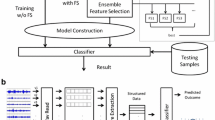Abstract
An automate classification of EEG time segments is frequently used technique across many neuro-scientific fields. Generally, segment classification results in labeled EEG time segments (e.g. physiological brain activity, epileptic activity, muscle artifacts or electrode artifacts). However, currently used methods are usually tested on artificial surrogate data and more general validation approach is needed. Here, a generalized statistical model of commonly used discriminating features obtained from real EEG data is presented for the first time. Multivariate probability density functions (PDFs) of classes are fitted on more than twenty thousand of testing segments from human EEG. An unique testing set is designed using a recent non-linear dimension reduction technique. Parametric and non-parametric PDF estimators are applied and compared in sense of feature space model.
Access this chapter
Tax calculation will be finalised at checkout
Purchases are for personal use only
Similar content being viewed by others
References
Krajca, V., Petranek, S., Patakova, I., Värri, A.: Automatic identification of significant graphoelements in multichannel EEG recordings by adaptive segmentation and fuzzy clustering. In: International Journal of Bio-Medical Computing, 1991, vol. 28(1–2), pp. 7189. https://doi.org/10.1016/0020-7101(91)90028-d.
Prabhakar, S., K., Rajaguru, H.: Pca and k-means clustering for classification of epilepsy risk levels from eeg signals - A comparitive study between them. In: 2015 International Conference on Intelligent Informatics and Biomedical Sciences (ICIIBMS), 2015, pp. 83–86. IEEE. https://doi.org/10.1109/iciibms.2015.7439467.
Paul, K., Krajca, V., Roth, Z., Melichar, J., Petranek, S.: Comparison of quantitative EEG characteristics of quiet and active sleep in newborns. In: Sleep Medicine, 2003, vol. 4(6), pp. 543–552. https://doi.org/10.1016/j.sleep.2003.08.008.
Värri, A.: Algorithms and systems for the analysis of long-term physiological signals. In: Tampereen teknillinen korkeakoulu. Julkaisuja. Tampere University of Technology, 1992.
Sana Tmar-Ben Hamida, Beena Ahmed, and Thomas Penzel. A novel insomnia identiffcation method based on hjorth parameters. In: 2015 IEEE International Symposium on Signal Processing and Information Technology (ISSPIT), Abu Dhabi, 2015, pp. 548–552. IEEE, ISBN 9781509004812. https://doi.org/10.1109/isspit.2015.7394397.
Van der Maaten, L., Hinton, G.: Visualizing Data using t-SNE. In: Journal of Machine Learning, 2008, vol. 9, pp. 2579–2605.
Grießbach, G., Witte, H.: Complex adaptive procedures for EEG monitoring. In: Witte, H., Zwiener, U., Schack, B., Doering, A. (eds.) Quantitative and Topological EEG and MEG Analysis, In: Druckhaus Mayer Verlag Gmbh Jena - Erlangen, 1997, pp. 295–297.
Welch, P.: The use of fast fourier transform for the estimation of power spectra: A method based on time averaging over short, modiffed periodograms. In: IEEE Transactions on Audio and Electroacoustics, 1967, vol. 15(2), pp. 70–73. https://doi.org/10.1109/tau.1967.1161901.
Krajca, V., Petranek, S., Pietilä, T., Frey, H.: WaveFinder: A new system for an automatic processing of long-term EEG recordings. Quantitative EEG analysisclinical utility and new methods, 1993, pp. 103–106.
Ware, S., V., Bharathi HN.: Study of density based algorithms. In: International Journal of Computer Applications, 2013, vol. 69(26). https://doi.org/10.5120/12132-8235.
De Haan, W., Al Pijnenburg, Y., Lm Strijers, R., Van Der Made, Y., Van Der Flier, W. M., Scheltens, P., Stam, C. J.: Functional neural network analysis in frontotemporal dementia and Alzheimer’s disease using EEG and graph theory. In: BMC Neuroscience. 2009, vol. 10(1), 101. https://doi.org/10.1186/1471-2202-10-101. ISSN 1471-2202.
Easwaramoorthy, D., Uthayakumar. R.: Analysis of EEG signals using Advanced Generalized Fractal Dimensions. In: 2010 Second International conference on Computing, Communication and Networking Technologies. IEEE, 2010, pp. 1–6. https://doi.org/10.1109/icccnt.2010.5591775. ISBN 978-1-4244-6591-0.
Acknowledgements
This work was supported by the Grant Agency of Czech Republic with the topic: Temporal context in analysis of long-term non-stationary multidimensional signal, register number 17-20480S, by the Grant Agency of the CTU in Prague, registration number SGS18/159/OHK4/2T/17 with the topic: Feature space analysis using linear and nonlinear reduction of EEG space dimensions.
Author information
Authors and Affiliations
Corresponding author
Editor information
Editors and Affiliations
Ethics declarations
The authors declare that there is no conflict of interest regarding the publication of this article.
Protection of Human Subjects and Animals in Research
The procedures followed were in compliance with the ethical standards of the responsible committee on human experimentation (institutional and national) and with the World Medical Association Declaration of Helsinki on Ethical Principles for Medical Research Involving Human Subjects.
Statement of Informed Consent
The study protocol and patient informed consent have been approved by the Bulovka Hospital.
Rights and permissions
Copyright information
© 2019 Springer Nature Singapore Pte Ltd.
About this paper
Cite this paper
Piorecký, M., Černá, E., Piorecká, V., Krajča, V., Koudelka, V. (2019). Simulation, Modification and Dimension Reduction of EEG Feature Space. In: Lhotska, L., Sukupova, L., Lacković, I., Ibbott, G. (eds) World Congress on Medical Physics and Biomedical Engineering 2018. IFMBE Proceedings, vol 68/2. Springer, Singapore. https://doi.org/10.1007/978-981-10-9038-7_80
Download citation
DOI: https://doi.org/10.1007/978-981-10-9038-7_80
Published:
Publisher Name: Springer, Singapore
Print ISBN: 978-981-10-9037-0
Online ISBN: 978-981-10-9038-7
eBook Packages: EngineeringEngineering (R0)




